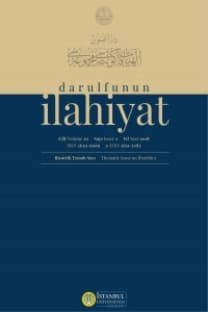Semerkandi'nin Tuhfetü'l-Fukaha İsimli Eserinde Hadis-i Nebeviyye Kullanımı
<!--
/* Font Definitions */
@font-face
{font-family:Arial;
panose-1:2 11 6 4 2 2 2 2 2 4;
mso-font-charset:0;
mso-generic-font-family:auto;
mso-font-pitch:variable;
mso-font-signature:-536859905 -1073711037 9 0 511 0;}
@font-face
{font-family:"Cambria Math";
panose-1:2 4 5 3 5 4 6 3 2 4;
mso-font-charset:0;
mso-generic-font-family:auto;
mso-font-pitch:variable;
mso-font-signature:-536870145 1107305727 0 0 415 0;}
@font-face
{font-family:Calibri;
panose-1:2 15 5 2 2 2 4 3 2 4;
mso-font-charset:0;
mso-generic-font-family:auto;
mso-font-pitch:variable;
mso-font-signature:-520092929 1073786111 9 0 415 0;}
@font-face
{font-family:"Palatino Linotype";
panose-1:2 4 5 2 5 5 5 3 3 4;
mso-font-charset:0;
mso-generic-font-family:auto;
mso-font-pitch:variable;
mso-font-signature:-536870265 1073741843 0 0 415 0;}
/* Style Definitions */
p.MsoNormal, li.MsoNormal, div.MsoNormal
{mso-style-unhide:no;
mso-style-qformat:yes;
mso-style-parent:"";
margin-top:0cm;
margin-right:0cm;
margin-bottom:10.0pt;
margin-left:0cm;
text-align:left;
line-height:115%;
mso-pagination:widow-orphan;
font-size:11.0pt;
font-family:Calibri;
mso-ascii-font-family:Calibri;
mso-ascii-theme-font:minor-latin;
mso-fareast-font-family:Calibri;
mso-fareast-theme-font:minor-latin;
mso-hansi-font-family:Calibri;
mso-hansi-theme-font:minor-latin;
mso-bidi-font-family:Arial;
mso-bidi-theme-font:minor-bidi;
mso-ansi-language:EN-US;}
.MsoChpDefault
{mso-style-type:export-only;
mso-default-props:yes;
font-size:11.0pt;
mso-ansi-font-size:11.0pt;
mso-bidi-font-size:11.0pt;
font-family:Calibri;
mso-ascii-font-family:Calibri;
mso-ascii-theme-font:minor-latin;
mso-fareast-font-family:Calibri;
mso-fareast-theme-font:minor-latin;
mso-hansi-font-family:Calibri;
mso-hansi-theme-font:minor-latin;
mso-bidi-font-family:Arial;
mso-bidi-theme-font:minor-bidi;
mso-ansi-language:EN-US;}
.MsoPapDefault
{mso-style-type:export-only;
margin-bottom:10.0pt;
line-height:115%;}
@page WordSection1
{size:612.0pt 792.0pt;
margin:72.0pt 90.0pt 72.0pt 90.0pt;
mso-header-margin:36.0pt;
mso-footer-margin:36.0pt;
mso-paper-source:0;}
div.WordSection1
{page:WordSection1;}
-->Semerkandî’nin Tuhfetu'l-Fukaha adlı
eseri Kudurî'nin el-Muhtasar'ına
dayanmasına rağmen o döneme kadar yazılan eserlerden farklı bir sistematiğe
sahiptir. Kudurî'nin eserini izah ve delillendirme amacıyla yazılan Tuhfetu'l-Fukaha tertip usulu ve
terminolojisi bakımından el-Muhtasar’dan daha ileri bir aşamayı temsil
eder. Makalemizde Taharet bölümünü seçmemizin sebebi müellifin takip ettiği
yöntemin diğer bölümlere de örneklik teşkil edeceği varsayımıdır. Çalışmamızda Semerkandî’nin mezkûra eserinin Taharet bölümündeki
hadisleri delil olarak kullanması üzerinde durulacaktır. Bu bakımdan bu bölümde
kaç hadisin hangi gerekçelerle kullandığı tespit edilmeye çalışılacaktır. Semerkandî, hadisleri Hanefi Mezhebinin görüşlerini güçlendirmek için
kullandığı gibi kendi görüşünü desteklemek ve muhalif görüşü çürütmek için de
kullanmıştır. O hadislerin lafızlarının yanında bazı zamanlar manalarını da
zikretmekte bazen de sahih hadislerle beraber zayıf hadisleri de delil olarak
kullanmaktadır.
Anahtar Kelimeler:
Sünnet, Hanefi mezhebi, içtihad, rey ehli, ihticac
Al-Samarqandī's Use of The Prophetic Hadīth in His Tuhfat al-Fuqahā
<!--
/* Font Definitions */
@font-face
{font-family:Arial;
panose-1:2 11 6 4 2 2 2 2 2 4;
mso-font-charset:0;
mso-generic-font-family:auto;
mso-font-pitch:variable;
mso-font-signature:-536859905 -1073711037 9 0 511 0;}
@font-face
{font-family:"Cambria Math";
panose-1:2 4 5 3 5 4 6 3 2 4;
mso-font-charset:0;
mso-generic-font-family:auto;
mso-font-pitch:variable;
mso-font-signature:-536870145 1107305727 0 0 415 0;}
@font-face
{font-family:Calibri;
panose-1:2 15 5 2 2 2 4 3 2 4;
mso-font-charset:0;
mso-generic-font-family:auto;
mso-font-pitch:variable;
mso-font-signature:-520092929 1073786111 9 0 415 0;}
@font-face
{font-family:"Palatino Linotype";
panose-1:2 4 5 2 5 5 5 3 3 4;
mso-font-charset:0;
mso-generic-font-family:auto;
mso-font-pitch:variable;
mso-font-signature:-536870265 1073741843 0 0 415 0;}
/* Style Definitions */
p.MsoNormal, li.MsoNormal, div.MsoNormal
{mso-style-unhide:no;
mso-style-qformat:yes;
mso-style-parent:"";
margin-top:0cm;
margin-right:0cm;
margin-bottom:10.0pt;
margin-left:0cm;
text-align:left;
line-height:115%;
mso-pagination:widow-orphan;
font-size:11.0pt;
font-family:Calibri;
mso-ascii-font-family:Calibri;
mso-ascii-theme-font:minor-latin;
mso-fareast-font-family:Calibri;
mso-fareast-theme-font:minor-latin;
mso-hansi-font-family:Calibri;
mso-hansi-theme-font:minor-latin;
mso-bidi-font-family:Arial;
mso-bidi-theme-font:minor-bidi;
mso-ansi-language:EN-US;
mso-fareast-language:EN-US;}
p
{mso-style-priority:99;
mso-margin-top-alt:auto;
margin-right:0cm;
mso-margin-bottom-alt:auto;
margin-left:0cm;
mso-pagination:widow-orphan;
font-size:12.0pt;
font-family:"Times New Roman";
mso-fareast-font-family:"Times New Roman";
mso-fareast-language:TR;}
.MsoChpDefault
{mso-style-type:export-only;
mso-default-props:yes;
font-size:11.0pt;
mso-ansi-font-size:11.0pt;
mso-bidi-font-size:11.0pt;
font-family:Calibri;
mso-ascii-font-family:Calibri;
mso-ascii-theme-font:minor-latin;
mso-fareast-font-family:Calibri;
mso-fareast-theme-font:minor-latin;
mso-hansi-font-family:Calibri;
mso-hansi-theme-font:minor-latin;
mso-bidi-font-family:Arial;
mso-bidi-theme-font:minor-bidi;
mso-ansi-language:EN-US;}
.MsoPapDefault
{mso-style-type:export-only;
margin-bottom:10.0pt;
line-height:115%;}
@page WordSection1
{size:612.0pt 792.0pt;
margin:72.0pt 90.0pt 72.0pt 90.0pt;
mso-header-margin:36.0pt;
mso-footer-margin:36.0pt;
mso-paper-source:0;}
div.WordSection1
{page:WordSection1;}
-->Islamic
schools of law agree on the validity of Sunna as the second source for
inferring legal rulings. There is no disagreement between the two main
approaches known as ahl al-hadith and ahl al-ra'y. However,
it became a misleading widespread argument that ahl al-ra'y especially Hanafis
rarely used hadith narration and that they preceded ra'y and qiyas over Sunna.
This argument has no sufficient evidence. The
Hanafi books, in fact, are full of hadith narrations whom they use as evidence
against their opponents including the jurists of ahl al-Hadith. As its status,
Hadith precedes qiyās according to Hanafis just like others. They do
not ignore any Hadith narration, unless it fails to reach their authenticity
conditions. Again, this is something common among all jurists and schools of
law. This
study investigates one of the well known law books of Hanafi school. It deals
with the chapter of taharah for its Hadith content and the method of its author
in using these narrations as evidence. The most important results
of this research are: al-Samarqandi used Hadith narration in his book either as
evidence for a ruling he relies on or to respond to his opponents. His
use of Hadith narration has a primary significance, not a secondary one
Keywords:
Prophetic Sunna, Hanafi school, ijtihad, legal reasoning of ahl al-ra'y,
- Yayın Aralığı: Yılda 2 Sayı
- Başlangıç: 1925
- Yayıncı: İstanbul Üniversitesi İlahiyat Fakültesi
Sayıdaki Diğer Makaleler
Türkiye’de Tarikatlar: Tarih ve Kültür
Çocuk Edebiyatına Bir Katkı Olarak “Çocuk Hutbeleri”
TEFSÎR LİTERATÜRÜNDE MÜSLÜMAN KADINLARIN EHL-İ KİTÂB ERKEKLERİ İLE EVLEN-ME(ME)LERİ MESELESİ
كتاب "جامع الدول" لمنجم باشي أحمد بن لطف االله وتاريخ دول العرب في عهد ثمانية سلاطين عثمانين نموذجً
AHMED HAMDİ AKSEKİ’NİN BİRDEN FAZLA EVLİLİK (TEADDÜD-İ ZEVCÂT) KONUSUNDAKİ YAKLAŞIMI
